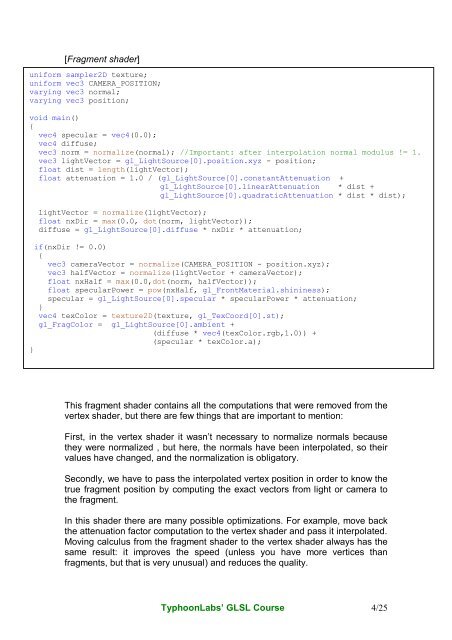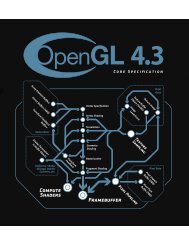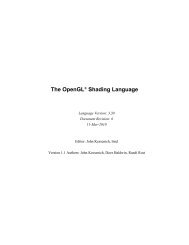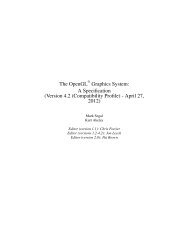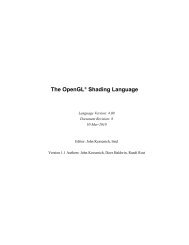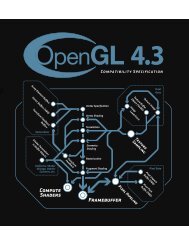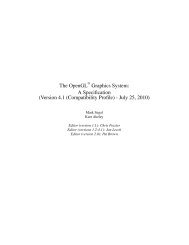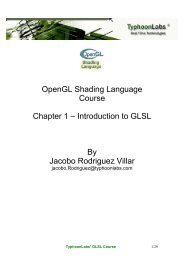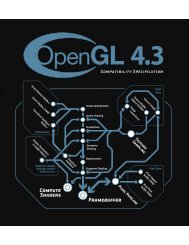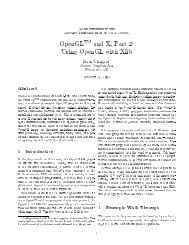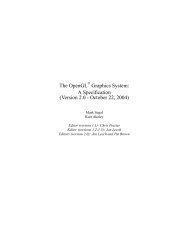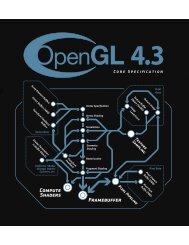OpenGL Shading Language Course Chapter 4 â Advanced Shaders ...
OpenGL Shading Language Course Chapter 4 â Advanced Shaders ...
OpenGL Shading Language Course Chapter 4 â Advanced Shaders ...
You also want an ePaper? Increase the reach of your titles
YUMPU automatically turns print PDFs into web optimized ePapers that Google loves.
[Fragment shader]<br />
uniform sampler2D texture;<br />
uniform vec3 CAMERA_POSITION;<br />
varying vec3 normal;<br />
varying vec3 position;<br />
void main()<br />
{<br />
vec4 specular = vec4(0.0);<br />
vec4 diffuse;<br />
vec3 norm = normalize(normal); //Important: after interpolation normal modulus != 1.<br />
vec3 lightVector = gl_LightSource[0].position.xyz - position;<br />
float dist = length(lightVector);<br />
float attenuation = 1.0 / (gl_LightSource[0].constantAttenuation +<br />
gl_LightSource[0].linearAttenuation * dist +<br />
gl_LightSource[0].quadraticAttenuation * dist * dist);<br />
lightVector = normalize(lightVector);<br />
float nxDir = max(0.0, dot(norm, lightVector));<br />
diffuse = gl_LightSource[0].diffuse * nxDir * attenuation;<br />
if(nxDir != 0.0)<br />
{<br />
vec3 cameraVector = normalize(CAMERA_POSITION - position.xyz);<br />
vec3 halfVector = normalize(lightVector + cameraVector);<br />
float nxHalf = max(0.0,dot(norm, halfVector));<br />
float specularPower = pow(nxHalf, gl_FrontMaterial.shininess);<br />
specular = gl_LightSource[0].specular * specularPower * attenuation;<br />
}<br />
vec4 texColor = texture2D(texture, gl_TexCoord[0].st);<br />
gl_FragColor = gl_LightSource[0].ambient +<br />
(diffuse * vec4(texColor.rgb,1.0)) +<br />
(specular * texColor.a);<br />
}<br />
This fragment shader contains all the computations that were removed from the<br />
vertex shader, but there are few things that are important to mention:<br />
First, in the vertex shader it wasn’t necessary to normalize normals because<br />
they were normalized , but here, the normals have been interpolated, so their<br />
values have changed, and the normalization is obligatory.<br />
Secondly, we have to pass the interpolated vertex position in order to know the<br />
true fragment position by computing the exact vectors from light or camera to<br />
the fragment.<br />
In this shader there are many possible optimizations. For example, move back<br />
the attenuation factor computation to the vertex shader and pass it interpolated.<br />
Moving calculus from the fragment shader to the vertex shader always has the<br />
same result: it improves the speed (unless you have more vertices than<br />
fragments, but that is very unusual) and reduces the quality.<br />
TyphoonLabs’ GLSL <strong>Course</strong> 4/25


